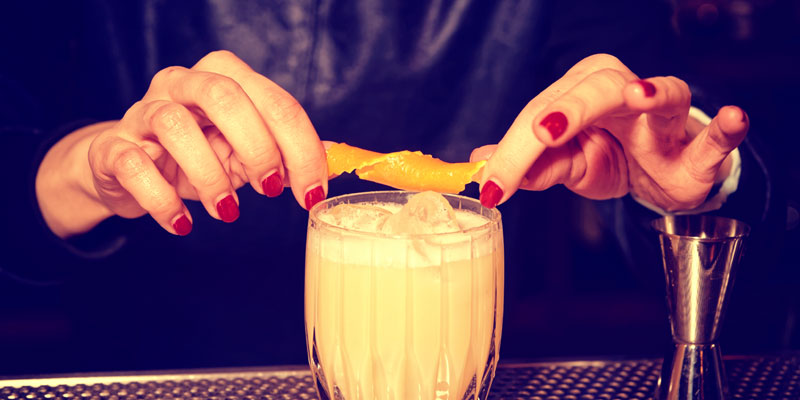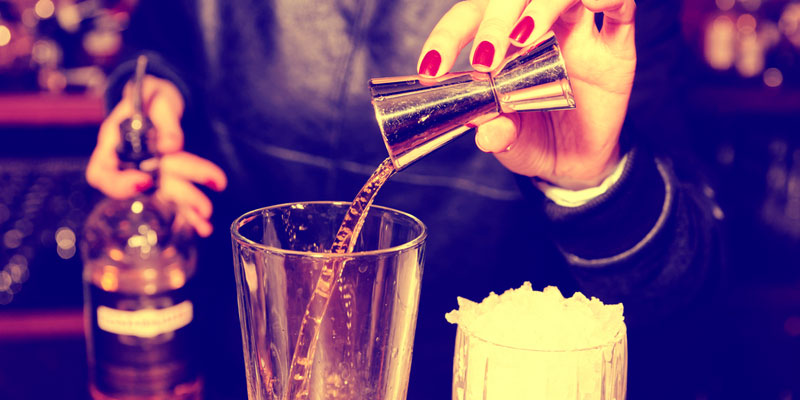Pay gap. Glass ceiling. Boys’ club. We hear these terms about many industries, and bartending isn’t exempt. But the similarities don’t end there. Just as in other industries, the ranks of bartenders were emptied out during the two world wars with the men off fighting, and just as in other industries, women stepped in to take their place. Of course, once the men came home, there was a backlash against these liberated libationists, with many states going as far as to make it illegal for women to serve alcohol. These laws were struck down after the Civil Rights Act of 1964 and, between 1970 and 1980, the number of women bartenders grew 323 percent. Today, 60 percent of bartenders are women.
“I think we’ve come a long way,” says Misty Kalkofen, director of Vino de Mezcal at Del Maguey.
But, according to others, and the data, there’s still more work to be done. Female bartenders earn 72.4 percent of what male bartenders earn, according to the U.S. Bureau of Labor Statistics.
“In our industry, women are kicking ass,” says Lynnette Marrero, beverage director at Brooklyn’s Llama Inn. “But as women get higher positions, the pay is less equal — that’s mirrored in pretty much every industry.”
“I haven’t had the displeasure of dealing with this issue,”says Jacyara de Oliveira, bartender at Rob Roy in Seattle. “However, I don’t think that is because it doesn’t exist. The business of cocktail bartending prides itself on an egalitarian opportunity where everyone is treated with the same amount of respect and gains the same rewards.”
In fact, many men and women say they’ve only worked in bars that pool tips, so they haven’t experienced the pay gap. However, the path to the positions women want isn’t always easy.
In a recent survey by Tales of the Cocktail, 47 percent of men and women said women face significantly higher barriers than men as they work to establish careers in the industry.
“I think across the industry you see a lot more discrepancies when it comes to hiring — more than pay,” de Oliveira says. “Higher-paying positions, like that of the steakhouse bartender for example, have traditionally gone to white men, while women and minorities were relegated to server and support staff positions.”
There is still the stereotype of bartending being a boys’ club, and women sometimes don’t get the same opportunities as men, says Sharon Bronstein, director of marketing for The 86 Co., whether that’s higher roles within bar programs or opportunities outside the bar, like speaking at conferences.
At times, that’s due to bar owners wanting a certain “image” for their brands, such as the clichéd team of men donning suspenders and mustaches. Other times, managers may still (wrongly) question if a woman can “handle” the physical aspects of the job, carrying ice buckets and being on their feet for hours.
“It’s a matter of trying to change perspective,” says Ivy Mix, co-owner and head bartender at Leyenda in Brooklyn. When she started in the cocktail industry, she wanted to be a bartender. “I was told, ‘But you’re a cocktail waitress,’ and I was like, ‘That’s all fine and good, I’m a good one, too,’” she says. “’But I want to bartend and create cocktails too.’ So I did.”
One night during the first Manhattan Cocktail Classic (MCC), a journalist came up to Mix and asked if she would do an interview because the reporter didn’t know any other women in the industry. Yet more than 20 women from Ladies United for the Preservation of Endangered Cocktails (LUPEC) were toiling away, doing all the volunteer efforts for MCC. “There was a basement full of women,” Mix says. “You just have to open your eyes.”
The incident was one thing that inspired her to co-found Speed Rack, a female bartender competition, with Marrero in 2011. “It’s an opportunity for women to showcase what they can do, in a really high-pressure environment,” Marrero says. “And it’s become a place where bar owners can scout talent.”
This year, the 86 Co. and Del Maguey partnered with Speed Rack to launch the Sisterhood Project. In each region of the competition, they’re surveying applicants about everything from their biggest work stressors and work-life balance to who their mentors are and what career goals they have.
“A lot of times, [Speed Rack] is just about being at a party,” Kalfoken says. “We wanted to create something the competitors could take away from the event, beyond the fun, and we felt there was an opportunity for more mentorship and creating a support system to talk about issues.”
Many men and women say the path from cocktail server or even bartender to where they ultimately want to go isn’t clear, and that needs to change. “There needs to be a better way of coming up through the ranks,” Marrero says, “a more systematic progress of what putting in that work means so it’s not as gendered. Everyone should have the opportunity to move up, and the Sisterhood Project aims to help women get what they want, whether that’s to be a bartender, bar owner or brand ambassador.”
Part of that is coaching women how to work in a business environment, making sure they’re being recognized for their work and teaching them to ask for what they’re worth.
Another part is supporting women who want to have a family someday. “There’s no such thing as maternity leave if you’re making most of your money from tips,” Kalfoken says. “Plus, it’s really hard to get leave and cover for six weeks and have those chips still there when you get back. And once you’re back to work, figuring out how to manage childcare can be challenging.”
By addressing each region’s top two concerns, the Sisterhood Project aims to help women not only with these challenges but also to provide them with resources for more support.
Women bartenders aren’t looking for a handout. None of them want to be hired just because they’re woman. They want to earn their positions and their pay and believe it should be that way for everyone. “Don’t just hire any girl you see because you need a woman behind the bar,” Mix says. “You should hire the best person and try to have those people be mixed genders.”
And then give those people who put in the work the same support and opportunities.


